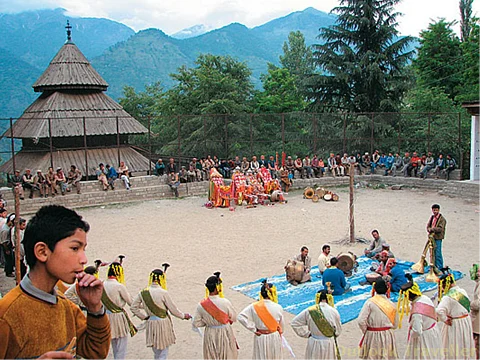
- Destinations
- Experiences
- Stay
- What's new
- Editor’s Picks
- Responsible Tourism
- CampaignsCampaigns
- Subscribe

For two days it was almost pin-drop silent. Then the hamlet exploded into song, dance and people. I asked my pahadi host about this sudden burst of kinetic energy. &ldquoOne Himachali is an apple farmer, two are a crowd, three are a Natti dance troupe and four Himachalis mean a mela is on in town,&rdquo he quipped. I had left the frenzy of Manali at the annual Dhungri mela, and was just settling into alluringly reticent Naggar when it dawned on me that I&rsquod arrived at the site of yet another fair &mdash the hamlet&rsquos biggest event, Shaadi Jatar (shaadi meaning June, with the ''''d' pronounced 'r').
My host explained again, &ldquoHimachal has not been termed &lsquodevbhoomi&rsquo on a whim. There are supposedly 18 crore deities. We have now struck off a few zeroes, reducing numbers of the divine to about 180. Melas remain the most popular idea of worship which means one mela every two days the year through.&rdquo The Shaadi Jatar was a five-day event, which meant my idea of an ideal break &mdash walking through Naggar&rsquos orchards, following its trekking trails, sitting under the pines, digging into local cuisine and some Italian fare in its woody mountain chalets &mdash was about to change.
Shaadi Jatar coincides with the flowering season and is held in honour of Naggar&rsquos reigning deity, Tripura Sundari, and her celestial brood &mdash Chamunda Mata, Patanti Devi, Bhidanti Devi, and Naag Devta. It&rsquos perhaps the only time when the crowds descend here, apart from the regular inflow of Roerich art estate-bound tourists.
If you can&rsquot escape them, join them, I decided. On each of the five days, the deities, all cast in silver, are smeared with vermillion, decked with flowers and settled on palanquins to be led in procession through surrounding villages. Musicians in ceremonial regalia pilot the proceedings, providing a score of high-pitched pahadi strains on the shehnai, narsingha, dhol and nagara. Locals &mdash mostly women dressed in brilliant-hued woven pattus and men flashing the Kullu topi&mdashjoined the parade as it zigzagged its way up and down the hill tracts to converge at the quad adjoining Tripura Sundari temple at Naggar by late afternoon, which is when public celebrations begin.
&ldquoEarlier, there was no concept of gathering at one place. The gods would go from house to house where individual prayers would be performed for a bountiful season. Today&rsquos population doesn&rsquot permit that,&rdquo the temple priest told me. I had been perplexed by the festival name. Why was Shaadi Jatar, which felicitates June, being held in May &ldquoIt used to be celebrated in June, which was the time for blossoms in the vales and fruit trees. Now this occurs in May. Changing seasonal patterns have lead to a shift in festival dates too. Though the jatar is held in Jeth (May), the old name continues,&rdquo he said. Also unchanged was the offering of seasonal flowers to the gods. But fruit flowers are not plucked. The priest was vociferous, &ldquoFruit blossoms are sacred. Plucking a flower from any fruit tree is akin to infanticide. You are killing the fruit in its womb.&rdquo
The mela venue was replete with buntings, Ferris wheel, food stalls, household articles on sale, fortunetellers and betting counters. I visited the totawala jodshi. The fortune-teller posed my queries to his all-knowing parrot, then shuffled the prediction cards and placed them before the bird. It pondered and pouted. It looked askance. And finally chose my card of destiny. The beak held the card until you placed the dakshina (offering) before his master. For a mere Rs 5, your future and the happiness it had in store were all yours. The spectator stand was by now a full palette of colours. An air of anticipation hung around the crowd. I inquired about the next event. &ldquoNatti,&rdquo replied a chorus of voices. I should have known&mdash&ldquothree Himachalis are a Natti troupe,&rdquo my host had joked. Here they were, in multiples of three.
I took my position to watch a performance of Kullu&rsquos favourite folk dance. Lilting voices buzzed around me till the drumming on a nagara filled the air the Nattis had arrived. Strings of woolly yellow flowers framed the faces of the dancers. From one end of the headgear emerged a spray of peacock and monal feathers. Men dressed in tunics, churidaars, sashes and the decorated berets perform Natti. Dancers link hands and move in step to varying rhythms (there are about 13 styles). Natti goes on for hours, with the crowd joining in once it picks up tempo.
After sundown, I returned to my host&rsquos residence, taking my place around a glowing fire by an apple tree. &ldquoThere is hardly any village where no fair is held. Yet if you&rsquove seen one, you haven&rsquot seen them all,&rdquo my host said. &ldquoThere is almost a continuous succession in your state,&rdquo I said. &ldquoI hope you are not headed for Bhuntar. The next fair is there,&rdquo he winked.
Melas in May
Shamshar Mahadev Anni Mela, Anni (near Jolori pass),
May 7-10
Banjar Mela, Banjar,
May 15-17 onwards
Sipi Mela, Sipur (Mashobra),
Mid-May
Dhungri Mela, Manali,
May 18-23
Shaadi Jatra, Naggar,
May 24-29
